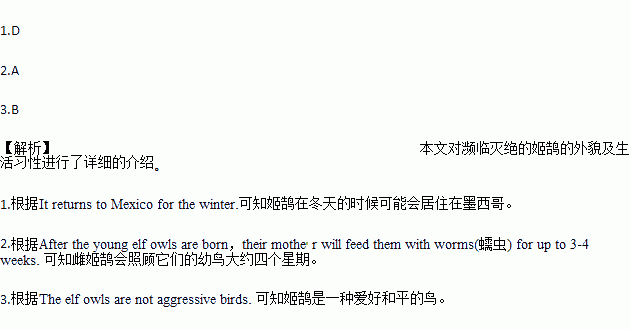题目内容
Amazing Facts About Elf Owls
Brief Introduction
The elf owl (a kind of owl) is mostly found in the southwestern parts of the United States and Mexico. During the spring and summer seasons, it moves to Arizona and New Mexico. It returns to Mexico for the winter. The elf owl doesn’t build its nest. It lives in tree holes.
Features
The elf owl is a yellow bird. Its wings are dark and about .48-61 centimeters long. Its eyes are bright yellow. Its feet are large. It is the smallest owl of the species. It is about 12.5-14.5 centimeters long. It is also the world’s lightest owl, weighing not more than 40 grams. In general, female elf owls weigh more than male ones.
The female usually lays three eggs at a time. After the young elf owls are born,their mothe r will feed them with worms(蠕虫) for up to 3-4 weeks. After 10 weeks, the young ones are fully grown and ready to take flight.
r will feed them with worms(蠕虫) for up to 3-4 weeks. After 10 weeks, the young ones are fully grown and ready to take flight.
Living Habits
The elf owls are not aggressive birds. When danger comes, they will fly away in the other direction, rather than stay and fact the danger or the enemies. Besides flying,the elf owl can also walk and climb like a parrot. The elf owl is most active after dusk,during the night, and just before dawn. It can produce many different kinds of sounds. It can live for 3-6 years in the wild. If they are kept in cages, they can live for 10-14 years. The elf owls are now in danger because of the loss of habitat. Cutting down trees will result in lack of places for them to live in.
1.According to the first and second paragraphs, an elf owl may _________ .
A. build its nest in trees B. have yellow wings
C. have big and dark eyes D. live in Mexico in winter
2.What can we learn from the text?
A. The female elf owl takes care of her children for about four weeks.
B. The elf owl sleeps at night and looks for food during the daytime.
C. The female elf owl lays one egg at one time.
D. The elf owl can live no longer than six years.
3.What is the character of the elf owl?
A. Shy. B. Peace-loving.
C. Hard-working. D. Selfish.

